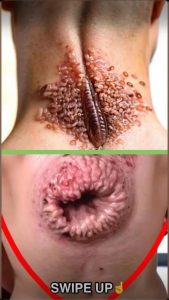🌀 Trypophobia: The Fear of Small Holes or Clusters

🌀 Trypophobia: The Fear of Small Holes or Clusters
Trypophobia is an aversion or fear of clusters of small holes, bumps, or patterns. Though not officially recognized as a mental disorder in the Diagnostic and Statistical Manual of Mental Disorders (DSM-5), many people experience intense discomfort, anxiety, or even panic when viewing images or objects that feature such patterns.
🧠 What Triggers Trypophobia?
Common trypophobia triggers include:
-
Honeycombs
-
Lotus seed pods
-
Coral
-
Sponges
-
Skin with pores or lesions (real or digitally edited)
-
Enlarged pores or holes in living tissue (realistic or fake)
-
Holes in bread, soap, or other everyday objects
Even digitally manipulated images, like the one you uploaded, are designed to provoke this fear or disgust.
😰 Symptoms of Trypophobia
People with trypophobia might experience:
-
Nausea or gagging
-
Goosebumps or itching
-
Sweating
-
Panic attacks or shortness of breath
-
Rapid heartbeat
-
Intense feeling of revulsion
🧬 Why Does It Happen? (Possible Causes)
The exact cause isn’t fully understood, but some theories include:
-
Evolutionary Defense Mechanism:
-
The brain may associate clustered holes with danger—such as skin diseases, parasites, or decaying flesh.
-
Evolution may have taught us to avoid patterns resembling harmful conditions.
-
-
Visual Overstimulation:
-
The brain struggles to process high-contrast patterns, creating sensory discomfort.
-
-
Psychological Association:
-
Some people develop the phobia after a traumatic experience linked to textures or patterns.
-
🛠️ Is There a Cure or Treatment?
While not a clinical disorder, people who are severely affected can seek help through:
-
Cognitive Behavioral Therapy (CBT)
-
Exposure therapy
-
Mindfulness techniques
-
Avoidance of known triggers
🧩 Fun Fact:
The word trypophobia comes from the Greek:
-
Trypo- (τρύπα) = “hole” or “drilling”
-
-phobia (φόβος) = “fear”
-
🦠 Parasitic Infection: A Deep Dive
A parasitic infection occurs when a parasite lives on or inside a host organism (such as a human), drawing nutrients at the host’s expense. These infections can cause a wide range of health problems, depending on the parasite involved and the area of the body affected.
🧬 What Is a Parasite?
A parasite is an organism that survives by feeding off another living being (the host). Unlike bacteria or viruses, parasites are typically eukaryotic organisms and often multicellular, though some, like protozoa, are microscopic.
🔍 Types of Parasitic Infections
-
Protozoa (Microscopic parasites)
-
Example: Giardia, Plasmodium (malaria), Toxoplasma gondii
-
Spread through: Contaminated water, food, or vectors like mosquitoes
-
-
Helminths (Worms)
-
Example: Tapeworms, roundworms, flukes
-
Spread through: Undercooked meat, contaminated soil, fecal-oral transmission
-
-
Ectoparasites
-
Example: Lice, mites, ticks, fleas
-
Live on: Skin or hair and feed on blood
-
🩺 Common Symptoms of Parasitic Infections
Symptoms vary by parasite type and infection site, but common ones include:
-
Diarrhea or gastrointestinal distress
-
Fatigue and weight loss
-
Skin rashes or lesions
-
Anemia
-
Itching or crawling sensation
-
Swollen lymph nodes
-
Fever
🌍 How Are They Contracted?
Parasitic infections are most common in areas with:
-
Poor sanitation
-
Unsafe drinking water
-
Inadequate healthcare access
Common transmission methods:
-
Contaminated food or water
-
Animal or insect bites
-
Direct skin contact with soil or infected surfaces
🧪 Diagnosis
Doctors may use:
-
Stool samples (for worms or protozoa)
-
Blood tests (for parasites like malaria)
-
Imaging scans (if parasites affect internal organs)
-
Biopsy in rare cases
💊 Treatment Options
-
Antiparasitic drugs: Like albendazole, metronidazole, ivermectin, praziquantel
-
Supportive care: For dehydration, anemia, or secondary infections
-
In rare cases: Surgery may be needed to remove cysts or parasites in tissues
🛡️ Prevention Tips
-
Wash hands frequently
-
Drink clean or boiled water
-
Cook meat thoroughly
-
Use insect repellents and nets in mosquito-prone areas
-
Avoid walking barefoot in tropical regions
⚠️ Example of a Scary Parasitic Infection
-
Botfly Larvae Infestation: The larva burrows under human skin and lives there, feeding and growing until removed. It causes visible lumps, pain, and intense discomfort — often referenced in horror media and shock images online.
-